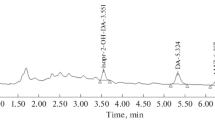Summary
A rapid method for the identification and determination of traces of chlorinated pesticides in crops, soils and animal tissues by gas-liquid chromatography with electron capture ionisation detection will be outlined. Only conventional G. L. C. equipment is required and neither preliminary „clean-up” nor concentration of the extract solution of the pesticide is, in general, necessary. In most cases the procedure is applicable to chlorinated pesticide residues in concentrations down to 0.1–0.25 ppm and a further increase in method sensitivity for a particular pesticide can generally be achieved by adjustment of sample volumes, operating conditions and/or the introduction of an extract „clean-up” stage. Interference present in extracts from grain samples can be resolved by the use of a polar G. L. C. column or removed by liquid-solid chromatography. The standard procedure devised requires about fifty minutes for a single analysis and only thirty minutes for serial analyses.
Résumé
Une méthode rapide pour l'identification et le dosage de traces d'insecticides chlorés dans les récoltes, les sols, et les tissus animaux, à l'aide de la chromatographie en phase gaz/liquide, sera exposé. Seuls, les instruments habituellement utilisés pour la chromatographie en phase gaz/liquide seront nécessaires, sans qu'il soit utile d'avoir recours à une purification préalable, ou à une concentration de la solution de l'extrait. Dans la plupart des cas, le procédé est applicable aux résidus d'insecticides chlorés ayant des concentrations de 0,1–0,25×10−6 et un accroissement de la sensibilité de la méthode vis-á-vis d'un insecticide particulier peut, en général, être obtenu par une mise au point de l'importance de la prise d'essai, des conditions opératoire, et/ou l'introduction d'un stade de purification de l'extrait. Les interférences possibles dans les extraits d'échantillons de grains, peuvent être éliminées par l'emploi d'une colonne polaire de chromatographie en phase gaz/liquide, ou encore à l'aide de la chromatographie en phase liquide/solide. Le procédé type qui a été mis au point, nécessite près de 50 minutes pour une seule analyse, et seulement 30 minutes pour des analyses en série.
Zusammenfassung
Eine Schnellmethode zur Identifizierung und Bestimmung von Spuren von chlorierten Insektiziden in Ernten, Böden und tierischen Geweben mittels Gas-Flüssigkeits-Chromatographie wird erörtert. Nur die zur Gas-Flüssigkeits-Chromatographie angewandten Apparate werden dazu benötigt, ohne vorherige Reinigung oder Konzentration der Extraktlösung. In den meisten Fällen ist das Verfahren für Rückstände von chlorierten Insektiziden anwendbar, welche Konzentrationen von 0,1–0,25 ppm aufweisen; eine erhöhte Sensibilität der Methode gegenüber speziellen Insektiziden kann durch Anpassung der Probenmenge der Arbeitsbedingungen und/oder der Einschaltung eines Reinigungsstadiums des Extraktes erhalten werden. Die bei Kornextrakt-Proben vorliegende Interferenz kann neutralisiert werden durch Anwendung einer polaren Chromatographiekolonne in flüssig-fester Phase. Das ausgearbeitete Standardverfahren benötigt 50 Minuten für eine Analyse und nur 20 Minuten für Serienanalysen.
Similar content being viewed by others
References
Needham, P. H.,Analyst, 1960, 85,792.
Coulson, D. M., Cavanagh, L. A. &Stuart, J.,J. Agric. Food Chem. 1959, 7,250.
Zweig, G. &Archer, T. E. Ibid. 1960, 8,190.
Wilkens Instrument and Research Inc., Walnut Creek, California, „Aerograph Research Notes”, Winter Issue, 1959.
Coulson, D. M., Cavanagh, L. A., de Vries, J. E. &Walther, B.,J. Agric. Food Chem. 1960, 8,399.
Zweig, G., Archer, T. E. &Rubenstein, D., Ibid. 1960, 8,403.
Lovelock, J. E. &Lipsky, S. R.,J. Amer. chem. Soc., 1960, 82,431.
Lovelock, J. E.,Anal. Chem. 1961, 33,162.
Goodwin, E. S., Goulden, R., Richardson, A. &Reynolds, J. G.,Chem. and Ind. 1960,1220.
Goodwin, E. S., Goulden, R. &Reynolds, J. G.,Analyst, 1961, 86,697.
Watts, J. O. &Klein, A. K.,J. Ass. Off. Agr. Chem. 1962, 45,102.
Harva, O., Kivalo, P. &Keltakallio. A.,Suomen Kemistilehti, 1957, 32B71;Chem. Abstr. 1959, 53,21359.
Bohemen, J., Langer, S. H., Perrett, R. H. &Purnell, J. H.,J. chem. Soc. 1960,2444.
Author information
Authors and Affiliations
Additional information
with 12 figs.
Rights and permissions
About this article
Cite this article
Goulden, R. The detection and determination of some chlorinated pesticide residues in crops, soils and animal tissues by gas-liquid chromatography. Plant Food Hum Nutr 11, 381–402 (1964). https://doi.org/10.1007/BF01102103
Published:
Issue Date:
DOI: https://doi.org/10.1007/BF01102103



